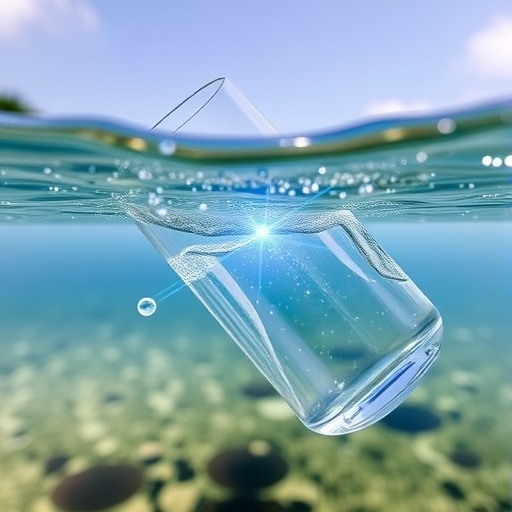In a groundbreaking study recently published, researchers have made significant advancements in the area of water purification, specifically in the removal of toxic metals from contaminated water. The collaborative work of Blanc, Maia, de Araújo, and their team presents a novel approach that combines the beneficial properties of nanomaterials and biomass in the creation of filters designed for this purpose. This innovative method utilizes the unique characteristics of nanoscale substances along with organic materials to enhance the efficiency of metal ion adsorption, opening new avenues for environmental remediation.
Pollution of water bodies due to industrial and agricultural waste has emerged as a critical global challenge, threatening ecosystems and human health alike. Toxic metals, such as lead, mercury, and cadmium, are particularly concerning due to their long-lasting presence in the environment and their ability to bioaccumulate. Traditional methods of remediation often fall short in efficacy and are cost-prohibitive, necessitating the urgent exploration of new techniques. The researchers’ study tackles this issue head-on, exploring a synergistic approach that leverages advanced materials science to tackle the problem effectively.
The incorporation of nanomaterials into water treatment processes offers promising benefits due to their high surface area and reactivity. These materials can enhance the interaction between contaminants and the adsorbent, significantly improving the effectiveness of the filtration system. Nanomaterials, such as carbon nanotubes and metal oxide nanoparticles, exhibit superior adsorption capacities and can facilitate rapid and efficient removal of heavy metals, a feature that is crucial for successful water purification strategies.
In this study, the researchers devised a filtration system that uses a composite of carefully selected nanomaterials integrated with biomass. This biocomposite not only serves as an effective adsorbent but also promotes environmental sustainability by utilizing organic waste. Materials like agricultural residue or other biomass types were chosen for their ability to capture heavy metals while generating less environmental impact compared to traditional synthetic filters. This biowaste approach not only adds an eco-friendly dimension to the filters but also ensures that the production of these filters can be viable on a commercial scale.
The experiment involved collecting contaminated water samples and subjecting them to the newly developed filtration system. Various tests were conducted to ascertain the performance of the filters, with metrics being evaluated to determine the removal efficiency of different toxic metals. Impressively, the results indicated that the biocomposite filters achieved removal efficiencies that surpassed many traditional methods. The team recorded significant reduction in metal concentrations, showcasing the potential for this technique in real-world applications.
The implications of this technology are immense, particularly in regions facing severe water contamination issues due to industrial processes or agricultural runoff. The ability to clean water effectively and affordably can lead to better health outcomes for local communities and ecosystems that rely on these water sources. By providing a sustainable solution that integrates both high-tech and low-tech elements, this research paves the way for more accessible water treatment options, especially in developing nations where resources are often limited.
Moreover, the findings of this study contribute to a broader understanding of nanobiocomposites in environmental applications. As challenges related to water pollution continue to escalate, scholars and practitioners in the field are compelled to innovate continuously. The combination of nanotechnology with renewable resources positions this research at the forefront of environmental science, encouraging further exploration and refinement of these composite materials.
Looking ahead, the potential for commercialization of these biocomposite filters appears promising. The underlying principles of the research lend themselves well to the development of scalable filtration systems that can be deployed in various settings, including industrial effluent treatment, community water supply systems, and emergency response scenarios where rapid water purification is essential. The researchers foresee collaborations with industry partners to bring this technology from the lab to the market.
The study also presents valuable insights into the interactions between different nanomaterials and biomass, forming a basis for future research endeavors. Understanding the mechanisms of adsorption at the molecular level will enable scientists to manipulate and optimize these materials further, leading to enhanced performance characteristics. This pursuit holds the potential not only to improve the efficacy of the filters but also to expand their applicability across a wider range of contaminants, beyond just toxic metals.
The research team recognizes that, while the current study marks a significant advancement, further validation in diverse environmental conditions is essential. Future research directions may include field trials that assess long-term effectiveness, as well as the development of methods for regenerating the filters without loss of performance. Additionally, exploring the economic feasibility of large-scale production will be fundamental in ensuring the accessibility of the technology.
Ultimately, this research signifies a pivotal step in the ongoing battle against water pollution. By synergistically combining the strengths of nanomaterials and biomass, the authors have not only addressed a pressing environmental issue but have also opened new discussions around sustainable and innovative engineering practices. As the world seeks effective solutions to combat the looming water crisis exacerbated by climate change and industrial expansion, such interdisciplinary research will become increasingly important.
In conclusion, the study elucidates how creativity in material science can lead to unprecedented advancements in environmental technology. As nations look toward achieving water security and promoting public health, innovations such as the nanomaterial and biomass combination filter could become essential elements in global strategies for clean water accessibility. The fusion of cutting-edge science and environmental stewardship exemplifies the type of transformative thinking necessary to address one of the most significant challenges of our time.
Subject of Research: Removal of toxic metals from contaminated water using nanomaterial and biomass filters.
Article Title: Removal of toxic metals in contaminated water by adsorption using filters with a combination of nanomaterial and biomass.
Article References:
Blanc, L.R., Maia, L.F.O., de Araújo, C.A.O. et al. Removal of toxic metals in contaminated water by adsorption using filters with a combination of nanomaterial and biomass.
Environ Monit Assess 197, 1107 (2025). https://doi.org/10.1007/s10661-025-14526-0
Image Credits: AI Generated
DOI:
Keywords: Water purification, nanomaterials, biomass, heavy metals, environmental remediation, filtration technology, sustainable solutions.




